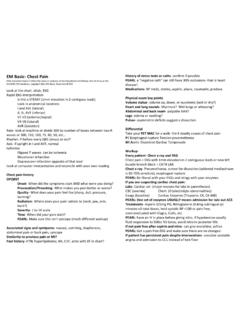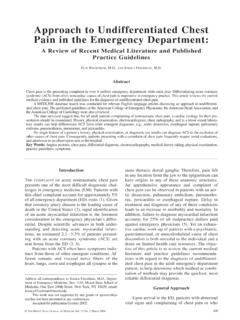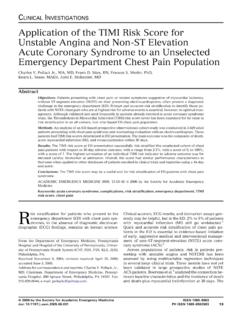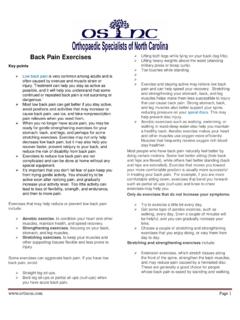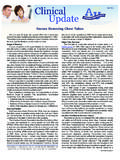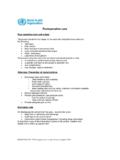Transcription of CHAPTER 53 - Approach to the Patient with Chest Pain
1 1076 CHAPTER 53 Approach to the Patient with Chest PainMarc S. Sabatine and Christopher P. CannonCAUSES OF ACUTE Chest pain , 1076 Myocardial Ischemia or Infarction, 1076 Pericardial Disease, 1076 Vascular Disease, 1077 Pulmonary Conditions, 1077 Gastrointestinal Conditions, 1077 Musculoskeletal and Other Causes, 1078 DIAGNOSTIC CONSIDERATIONS, 1078 Clinical Evaluation, 1078 Initial Assessment, 1078 Decision Aids, 1080 IMMEDIATE MANAGEMENT, 1080 Chest pain Protocols and Units, 1084 Early Noninvasive Testing, 1084 REFERENCES, 1085 Acute Chest pain is one of the most common reasons for presentation to the emergency department (ED), accounting for approximately 7 million ED visits annually in the United States.
2 This presentation sug-gests acute coronary syndrome (ACS), but after diagnostic evaluation, only 15% to 25% of patients with acute Chest pain actually have ,2 The difficulty lies in discriminating patients with ACS or other life-threatening conditions from patients with noncardiovascular, non life-threatening Chest pain . The diagnosis of ACS is missed in approximately 2% of patients , leading to substantial consequences for example, the short-term mortality for patients with acute myocar-dial infarction (MI) who are mistakenly discharged from the ED increases twofold over that expected for patients who are admitted to the hospital. For patients with a low risk of complications, however, these concerns must be balanced against the costs and inconvenience of admission and against the risk of complications from tests and procedures with a low probability of improving Patient recent advances have enhanced the accuracy and effi-ciency of the evaluation of patients with acute Chest pain , including better blood markers for myocardial injury,3 decision aids to stratify patients according to their risk of complications, early and even imme-diate exercise testing4 and radionuclide scanning for lower risk Patient subsets (see Chap.)
3 17),5 multislice computed tomography for the ana-tomic evaluation of coronary artery disease, pulmonary embolism, and aortic dissection (see Chap. 19),6 and the use of Chest pain units7 and critical pathways for efficient and rapid evaluation of lower-risk of Acute Chest PainIn a typical population of patients presenting for the evaluation of acute Chest pain in EDs, about 15% to 25% have acute MI or unstable A small percentage have other life-threatening problems, such as pulmonary embolism or acute aortic dissection, but most are discharged without a diagnosis or with a diagnosis of a noncardiac condition. These noncardiac conditions include musculoskeletal syn-dromes, disorders of the abdominal viscera (including gastroesopha-geal reflux disease), and psychological conditions (Table 53-1).
4 Myocardial Ischemia or InfarctionThe most common serious cause of acute Chest discomfort is myocar-dial ischemia or infarction (see Chaps. 54 to 56), which occurs when the supply of myocardial oxygen is inadequate compared with the demand. Myocardial ischemia usually occurs in the setting of coro-nary atherosclerosis, but it may also reflect dynamic components of coronary vascular resistance. Coronary spasm can occur in normal coronary arteries or, in patients with coronary disease, near athero-sclerotic plaques and in smaller coronary arteries (see Chap. 52). Other less common causes of impaired coronary blood flow include syndromes that compromise the orifices or lumina of the coronary arteries, such as coronary arteritis, proximal aortitis, spontaneous coro-nary dissection, proximal aortic dissection, coronary emboli from infectious or noninfectious endocarditis or thrombus in the left atrium or left ventricle, myocardial bridge, or a congenital abnormality of the coronary arteries (see Chap.)
5 21).The classic manifestation of ischemia is angina, which is usually described as a heavy Chest pressure or squeezing, a burning feeling, or difficulty breathing (see Chap. 12). The discomfort often radiates to the left shoulder, neck, or arm. It typically builds in intensity over a period of a few minutes. The pain may begin with exercise or psycho-logical stress, but ACS most commonly occurs without obvious precipi-tating descriptions of Chest pain reduce the likelihood that the symptoms represent myocardial ischemia or injury. The American College of Cardiology (ACC) and American Heart Association (AHA) guidelines list the following as pain descriptions that are not charac-teristic of myocardial ischemia8.
6 Pleuritic pain ( , sharp or knifelike pain brought on by respira-tory movements or cough) Primary or sole location of discomfort in the middle or lower abdominal region pain that may be localized at the tip of one finger, particularly over the left ventricular apex pain reproduced with movement or palpation of the Chest wall or arms Constant pain that persists for many hours Very brief episodes of pain that last a few seconds or less pain that radiates into the lower extremitiesData from large populations of patients with acute Chest pain indicate that ACS occurs in patients with atypical symptoms with sufficient frequency that no single factor should be used to exclude the diagnosis of acute ischemic heart disease.
7 In particular, women, older persons, and individuals with diabetes may be more likely to report atypical symptoms of myocardial ischemia or infarction (see Chap. 81).Pericardial DiseaseThe visceral surface of the pericardium is insensitive to pain , as is most of the parietal surface. Therefore, noninfectious causes of pericarditis ( , uremia; see Chap. 75) usually cause little or no pain . In contrast, infectious pericarditis almost always involves surrounding pleura, so that patients typically experience pleuritic pain with breathing, coughing, and changes in position. Swallowing may induce the pain because of the proximity of the esophagus to the posterior heart. Because the central diaphragm receives its sensory supply from the phrenic nerve, and the phrenic nerve arises from the third to fifth cervi-cal segments of the spinal cord, pain from infectious pericarditis is frequently felt in the shoulders and neck.
8 Involvement of the more lateral diaphragm can lead to symptoms in the upper abdomen and CH 53 Approach To THE Patient with Chest pain 1077 Pulmonary ConditionsPulmonary conditions that cause Chest pain usually produce dyspnea and pleuritic symptoms, the location of which reflects the site of pulmonary disease. Tracheobronchitis tends to be associated with a burning midline pain , whereas pneumonia can produce pain over the involved lung. The pain of a pneumothorax is sudden in onset and is usually accompanied by dyspnea. Primary pneumotho-rax typically occurs in tall, thin young men; secondary pneumothorax occurs in the setting of pulmonary disease such as chronic obstructive pulmonary disease, asthma, or cystic fibrosis.
9 Asthma exacerbations can present with Chest discomfort, typically characterized as ConditionsIrritation of the esophagus by acid reflux can produce a burning dis-comfort that is exacerbated by alcohol, aspirin, and some foods. Symptoms often are worsened by a recumbent position and relieved by sitting upright and by acid-reducing therapies. Esophageal spasm can produce a squeezing Chest discomfort similar to that of Mallory-Weiss tears of the esophagus can occur in patients who have had prolonged vomiting episodes. Severe vomiting can also cause esophageal rupture (Boerhaave syndrome) with mediastinitis. Chest pain caused by peptic ulcer disease usually occurs 60 to 90 minutes after meals and is typically relieved rapidly by acid-reducing therapies.
10 This pain is usually epigastric in location but can radiate into the Chest back, creating confusion with pancreatitis or cholecystitis. Pericarditis occasionally causes a steady, crushing substernal pain that resembles that of acute myocardial DiseaseAcute aortic dissection (see Chap. 60) usually causes the sudden onset of excruciating ripping pain , the location of which reflects the site and progression of the dissection. Ascending aortic dissections tend to manifest with pain in the midline of the anterior Chest , and posterior descending aortic dissections tend to manifest with pain in the back of the Chest . Aortic dissections are rare, with an estimated annual incidence of 3/100,000, and usually occur in the presence of risk factors including Marfan and Ehlers-Danlos syndromes, bicuspid aortic valve, pregnancy (for proximal dissections), and hypertension (for distal dissections).
